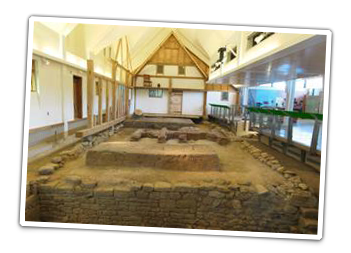Maryland Archaeology: Excavations of St. Mary’s City
In 1634 St. Mary’s City was established near the serene junction of the Potomac River and Chesapeake Bay. For 61 years, this first city in Maryland served as the colony’s capital. When the seat of government was moved to Annapolis, the town was virtually abandoned and left to crumble into the soil. For over 300 years, the fragile remains of the town lay concealed beneath fields of tobacco, corn and wheat. Agriculture protected the archaeological treasure and preserved an unparalleled resource for the study of Early America. The National Park Service has recognized St. Mary’s City as “probably the most intact 17th-century English town surviving in our nation…represented entirely by archaeological resources.” St. Mary’s City offers a rare opportunity for researchers to coax information about the Maryland colony and people’s lives from a priceless archaeological record.
Keeping a Promise to the Past
Find out about Archaeology and Artifact Conservation at Historic St. Mary’s City. Learn about Metals, Organics, Glass and Ceramics and how the team learns about the past from these fragments.
St. John’s Freehold
Over the archaeological excavation of St. John’s Freehold, one of the state’s most important historical sites, a major exhibit has been constructed. At this site Maryland’s citizen government was instituted and the place of religion in a secular society was examined and debated. St. John’s has yielded an amazing wealth of information about Maryland’s beginnings and the development of a new colonial society.
Reconstructing the Chapel
The ca.1667 Brick Chapel has been beautifully reconstructed on its original foundation. An adjacent exhibit helps tell the significant story of early Maryland, the birthplace of religious freedom in America.
Van Sweringen’s Inn
One of the most intriguing residents of Maryland’s first capital was Garrett Van Sweringen. Most everything we know about the Van Sweringen site is the result of years of careful archaeological research. Explore the site with this interactive map.
The Lead Coffins of St. Mary’s
In 1990, three rare seventeenth-century lead coffins were found inside the ruins of the chapel. Recovering the unique information the coffins held and excavation of other graves in the chapel cemetery, have enabled the museum to make a major contribution to the existing knowledge about life and death in the colonial Chesapeake.
Mystery Solved!
Our Lead Coffins are back in the news! Find out what we’ve learned from the 300-year-old remains of the baby.
Reconstructing the Print House
Excavations in 1992 discovered a site containing a quantity of lead type. Written documents and archaeological excavations indicate that this was where the first press was established in the English southern colonies. The Print House has been reconstructed and furnished as a living history exhibit.
St Mary’s City Collections
Artifacts found here represent multiple periods of time-various eras of prehistory, seventeenth century, eighteenth century, and up to the present. Let us introduce to you a few of the treasures we have discovered.
Field School
Under the direction of the Chief Archaeologist, each summer students from across the United States and the world attend field school to learn the techniques and skills of archaeology as they uncover new evidence of lives and landscapes past.
All of Us Would Walk Together
An Exhibit on the Transition from Slavery to Freedom at St. Mary’s City
 Dig deeper into the archaeology of Historic St Mary’s City.
Dig deeper into the archaeology of Historic St Mary’s City.





